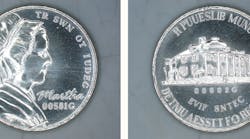Nickels are ubiquitous in American life, but these resilient and somewhat humble-looking coins are also becoming costly to produce. Nickel, the coin’s own namesake, for example, has become a prized ingredient in many modern products, pushing the market value so much that sometimes making the five-cent coin costs as much as seven cents a pop.
Working with the U.S. Mint, a research team at the National Institute of Standards and Technology (NIST) has identified an alternative approach that would reduce the material cost for the nickel by as much as 40%. This approach would produce a coin every bit as tough and reliable as the old nickel, but also every bit as familiar.
As an added benefit, data from this research has also yielded results that may aid high-tech companies looking for new materials to use in durable electronics such as phones and laptops—and in a variety of radical new colors, to boot.
Manufacturing coins is a complicated and demanding process. Coins must not corrode in the palm of a moist hand, for example. Images stamped on their faces must be resilient enough to withstand decades of commerce and the occasional turn through the washing machine. Their metallic sheen must always be recognizable, and of uniform thickness and density.
Although invisible to average consumers buying a gumball or soda, all U.S. coins must contain a predetermined amount of electrical conductivity to work in vending machines, which use a small meter to determine a coin’s currency signature. A parking meter or soda machine won’t count your nickel without this key characteristic.
In many ways, the nickel-redesign challenge was an ideal match for the NIST Materials Genome Initiative (MGI), which was started in 2011 with the ambitious goal of decreasing the time it takes new materials to reach market by at least half while keeping costs low. MGI has been building computational and IT tools needed for developing all kinds of new materials for use in a wide variety of manufacturing applications.
“Rethinking the nickel was one of the first times we could use the new MGI tools to design a material for a specific application,” says NIST scientist Carelyn Campbell.
The NIST team worked backward, first identifying the desired qualities for the new five-cent piece and then figuring out which alloys and procedures might be needed to make it. The U.S. Mint also outlined some site-specific constraints; namely, the new coin had to be made using existing manufacturing facilities in Denver and Philadelphia, both of which use a specific type of slow-cooling process.
Color proved particularly challenging. Although most people would not think of coins as having special tones or hues, coin collectors are a demanding group and will often reject coins even slightly off-tone—and collectors form a significant share of the market for currencies. The public might not trust coins that are too orange or too yellow. But color is often subjective, and one can be hard to quantify or reproduce with to any kind of reliable standard.
In this case, using the MGI process proved enormously helpful—surprising even the researchers with how efficient it was. Starting with the set of parameters for resilience, conductivity, and color, the team developed a new mix of copper, nickel, and zinc that was 40% less expensive than the currently used metal mix.
The team relied heavily on a type of materials design known as Integrated Computational Materials Engineering (ICME). It uses a large amount of computer modeling to discover how different components will react when mixed together. In this case, those components were metal alloys.
Experimental work is costly and time-consuming, whereas running a model on a computer is fast and cheap. The idea is to use more computational resources and tools to do the legwork in the design stage to cut down on the time and costs needed to go from idea to reality.
“Within a year, we put together a framework for designing an alloy, identifying and using our model to get the correct alloy, and then moving forward and actually making the prototype, testing it out, and discovering we met all of our goals,” says NIST project leader and materials engineer Eric Lass. In the past, such work would have taken several years.
The results could potentially save the U.S. Mint millions. In addition, several companies that manufacture high-tech items have shown an interest in the results based on the strong consumer demand for electronics that are durable, but also available in a variety of colors such as metallic pink.

